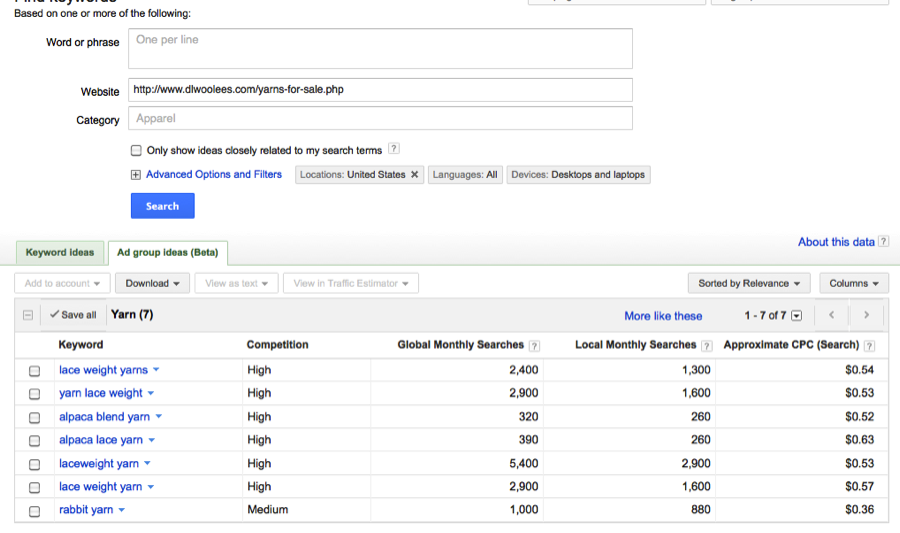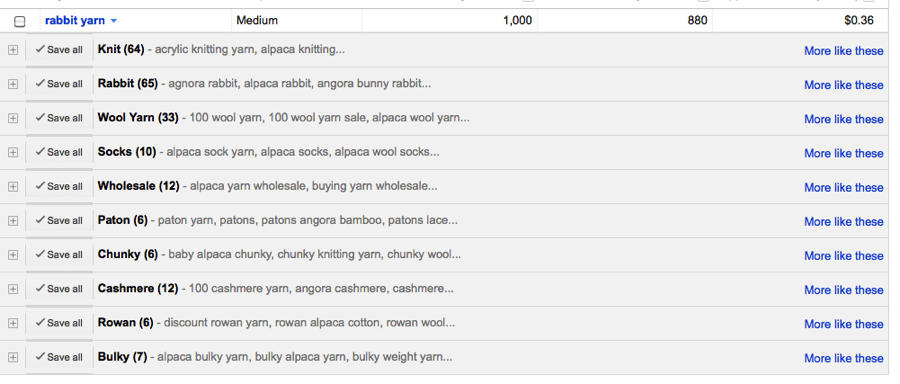Starting PPC For eCommerce Sites: A Beginner’s Handbook Part 1

In part 1, we’ll cover Advertising Platforms, eCommerce Tracking, and Keyword Research.
You’ve come up with the perfect eCommerce site. Maybe you got in on a great wholesale deal for miniature furniture for dollhouses. Maybe you spin your own yarn out of your angora bunny’s hair and it’s selling like proverbial hot cakes. But, you seem to have reached your limit for growth through the marketing channels (or lack thereof) you’re already using. Someone or something told you about PPC, and you were interested enough to look into it. Well, this handbook is just for you. I made it for yooooou.
Advertising Platforms
There are a lot of options out there for advertising platforms despite the fact that most people just think of BingAds and AdWords when it comes to PPC. Of course, the best place to start is AdWords due to its audience size, ease of use, and available tools. But there are other fish in the sea. This is especially true for eCommerce. If you have a product that has awareness, and you’re competitive on price points, then comparison shopping sites are great places to start along with BingAds and AdWords.
Here’s a quick list of comparison shopping sites:
Shopzilla, Bizrate, InStore.com
No set-up fees, strictly ppc. 1. Create merchant account. 2. fund account with refundable $50 deposit. 3. Submit products. Advertises on BizRate and AOL’s InStore.com as well. Includes built in reporting features.
Difference between advertising & selling on the site. They claim to be the #1 comparison site in traffic, revenue, and GMV. Free ROI tracking system, Promotional messaging platform for voucher codes, buyer reviews and trusted seller program. Only pay “when we refer you to a qualified lead”. No listing fees or set-up costs.
Sign up for a merchant account, use a product feed, and it’s all free. Hybrid between Amazon and PLAs.
Product ads! Upload manually or with FTP. They create ads using the info provided, set your own budgets. Click-through to your website. You pay a CPC fee only. Formats: Detail page, Search & browse, Buy Box, Tower Ads. $75 in free clicks!
Sign up for a merchant account, upload data feed, must fund the account with a paypal account. Provides ROI tracker and survery tool. CPC pricing. Minimum $100 to start.
Tracking
Implementing the proper eCommerce tracking code prior to setting up your PPC campaigns is of the utmost importance when it comes to tracking goals and optimizing your accounts. The best place to set up tracking is with Google Analytics, since it will allow you to integrate information with your AdWords accounts.
Here is a guide for how to enable the code in your Analytics account. Here is a guide for how to implement the code on your site. This is where is gets pretty technical, and if you are totally tech illiterate, then it’s going to be WELL worth your money to hire a freelancer to do this for you.
The eCommerce cart system you use can affect how you place this code and the functionality. You may want to start by talking with a rep from your cart system if you aren’t sure how to place the code, or if it will have problems working with your cart system.
Here’s a cautionary tale, as an example: UltraCart requires you to pay a certified UltraCart professional hundreds of dollars to integrate this tracking with your cart. They keep some information in a back-end system that you don’t have access to, so even if you hire a freelancer, they will not be able to set up eCommerce tracking for you properly.
While it may be a pain for you, financially or otherwise, to get this tracking implemented, my advice is that you shouldn’t even bother thinking you can do PPC for eCommerce without proper tracking.
Keyword Research
The best place to start keyword research is right on your site! I find eCommerce keyword research the easiest and most straight-forward. Your products are the place to start. Go through all your products and pick out all the keywords that people would be searching for to find them. To make setting up your account easier, make sure you keep these keywords grouped by product.
To get a good amount of the work done rather quickly, I’d suggest using the Google Keyword Tool.
I put in a website that sells angora rabbit yarn and got this, for example:  Each keyword is clickable, and you can use Google Insights for search to see how traffic for that keyword is doing, and you can instruct the tool to find more keywords like that.
Each keyword is clickable, and you can use Google Insights for search to see how traffic for that keyword is doing, and you can instruct the tool to find more keywords like that.
For instance, I told it to “show me more like this” for “rabbit yarn” and found this:
Each one of these categories can be expanded to show a whole slew of keywords. So, I suggest using this tool to get a bulk of keywords with minimal effort. You can export keywords into an Excel doc to scan through, or scan through and select “exclude term” right in the tool. Then, if you’ve got your AdWords account set up with your billing information just to start, you can import this stuff right into your account.
The groupings you see above are suggested ad groups. We’ll get more into strategy for account structure, but just keep in mind that you should keep product keywords grouped together by product. So, keep rabbit yarn keywords together, any yarn accessories you sell together, etc.
Stay tuned next week for Part 2 of Starting PPC For eCommerce Sites: A Beginner’s Handbook, in which we’ll cover account structure & budgeting.




